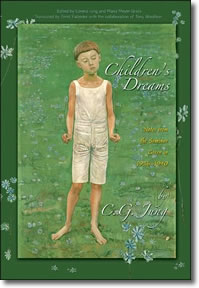Children’s Dreams
Notes from the Seminar Given in 1936-1940
by C. G. Jung
 Edited by Lorenz Jung and Maria Meyer-Grass
Edited by Lorenz Jung and Maria Meyer-GrassPublished by Princeton University Press, March 2008
Do you remember any of the dreams of your childhood? If you are intrigued by the meaning and significance of your dreams, you’ll be fascinated by Children’s Dreams, a fat new addition to Carl Jung’s Collected Works published by Princeton.
Christian spiritual thinking has changed due to the work of eminent psychologist (perhaps the most important in history) and religious thinker Carl Gustav Jung (1875-1961). In particular, his influence is felt in the teachings and the books of people like Thomas Keating, Morton Kelsey, Richard Rohr, and John O’Donahue. Jung grew up the son of a pastor in rural Switzerland, and he spent much of his life trying to find new ways to appreciate and understand both organized religion and a personal, spiritual approach to God.
Jung taught that we rely too much on science and logic and need to integrate spirituality and an appreciation of the unconscious realm into every aspect of our lives. In Children’s Dreams, he prompts us to recall our dreams, and then guides us like a clinician to understand the archetypes at play in the details. Jung’s other works on the meaning of dreams were well-known among psychologists and students in the 1930s, but have had limited exposure since that time. This book will change that.
Once a student and best friend to Sigmund Freud, the founder of psychoanalysis, it is said that when Jung and Freud first met, their conversation lasted for nearly twelve hours. For six years after that first meeting, they were each other’s closest friend and colleague, until a falling out occurred in 1910.
Perhaps Jung’s most significant and far-reaching contribution has to do with his conviction that spiritual experience, and acknowledging a need for spiritual help, plays an essential part in overcoming alcohol addiction. His ideas were instrumental to Bill Wilson (later known as “Dr. Bill”) in his co-founding of Alcoholics Anonymous.
Today, among those who read books in religion, Jung is best known for his little masterpiece Answer to Job (now vol. 11 in the Collected Works), dealing with the universal issue of God’s role in human suffering as depicted in the classic book from the Hebrew Bible. Jung criticizes Yahweh, the Hebrew name for God, pointing out his faults in dealing with the man, Job; and he psychoanalyzes Yahweh, as well, trying to understand why God would do what the Book of Job has God doing.
In Children’s Dreams, we get fresh and more personally applicable material from this interesting thinker. Material that speaks to intriguing questions: What do dreams represent in our lives? Do they foretell the future? Do they speak to our frustrations and emotions that we are otherwise somehow unable to express? Is it healthy to dream?
Children’s Dreams addresses all of these using the dreams we have as children as its focal point, because these are often the yearnings and confusions that have stuck with us well into adulthood.To understand the dreams that we had as children is to become healthier adults.
Above all, Jung emphatically says that we should be trying to recall, write down, analyze, and learn from our dreams. That’s the first step. “Your vision will become clear only when you look into your heart. Who looks outside, dreams. Who looks inside, awakens,” he once told an audience.
He also was the one who said, “Everything that irritates us about others can lead us to an understanding of ourselves.”
Jung believed that dreams carry in them a wealth of symbolic language and image. Many of these symbols are what he calls archetypes, or deeply-rooted images and experiences naturally found in the minds and imaginations of all people because of our shared experience, or what Jung called our “collective unconscious.” Elsewhere, he called an archetype a “preconscious psychic disposition that enables a [you] to react in a human manner.” Learning to recognize archetypes in our dreams is rewarding—and something that anyone can do with practice.
Jung also taught that you often cannot isolate a dream and analyze its meaning apart from others. This is why writing down our dreams is so important. Sometimes to understand one dream is to see it in the context of dreaming over a longer period of time.
In Children’s Dreams, you will
benefit from the hundreds of specific cases of Jung’s students, and you will be
on your way to discovering more of the rich meaning taking place during one
third of your life— the time you spend in sleep!
Copyright ©2008 Jon Sweeney

Help explorefaith.org. Purchase a copy of CHILDREN'S DREAMS by following this link to amazon.com.